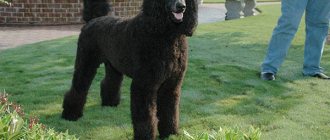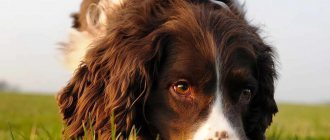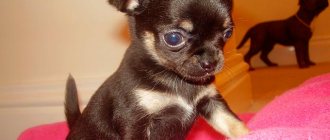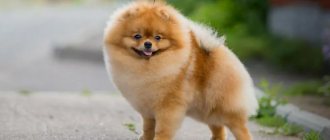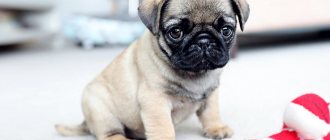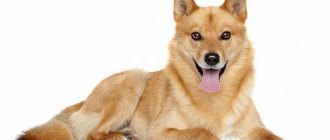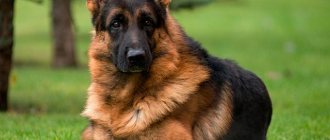When a cute and funny husky puppy appears in the house, the last thing its owners think about is how long dogs of this breed live.
Vaccinations, first walks, exhibitions, sports competitions - these are the things that usually worry the owners of young dogs.
But time passes, and sooner or later the moment comes when the owner first notices gray hair on the face of his husky.
And then the owner thinks about how he can prolong the life of the pet?
Life expectancy for boys and girls
On average, the life expectancy of Husky is 12-15 years.
However, how long a pet will live depends to a large extent on the conditions of its keeping, diet, physical activity and many other reasons. Only if all these conditions are met will the husky live to these years.
If the pet is poorly cared for, not given enough walks, does not take care of its health, and at the same time is fed anything, then the dog will hardly be able to live up to 10 years.
IMPORTANT!
With good care and maintenance, the life expectancy of a husky can reach 25 years.
Speaking about who lives longer - boys or girls, it should be noted that males of this breed have a predisposition to diseases of the genitourinary system, which can significantly shorten their life.
It is also believed that older Husky males are more likely than females to develop hypertension, which can also affect their life expectancy.
However, Husky girls, due to improper breeding or under the influence of certain drugs that affect reproductive function, can also develop diseases of the genitourinary system, for example, pyometra, which often leads to very serious complications and even death.
If the owner of a husky does not intend to get offspring from his dog and at the same time wants to prolong its life, he can resort to sterilization or castration.
How long do dogs live when kept on the street?
Living conditions similar to those to which huskies have been accustomed for centuries help to prolong the life of these dogs.
If for representatives of many other breeds living in a yard or in an enclosure in a private home can negatively affect their health, for huskies this, on the contrary, is the best possible living conditions.
Clean air, the opportunity to move as much as the dog wishes and the natural change of weather have a beneficial effect on their well-being.
A Husky kept outdoors can live up to 20-25 years.
Expert opinion
Kozhevin Semyon Kirillovich
Expert dog handler.
“On average, Siberian huskies live 12-15 years. However, how long a pet can live primarily depends on where it is kept. Dogs living in an apartment and suffering from lack of exercise can live 10-12 years. In rural areas, huskies have a good chance of living to 20 or even 25 years. As for the lifespan depending on the gender of the dog, in most cases, it does not significantly affect how long the pet will live.”
Origin of the breed
Huskies are the result of crossing domestic dogs with wild wolves. They look like forest predators and have similar genes.
The Chukchi were the first to breed this breed in Neolithic times. Residents of the Far North needed a dog that would not be afraid of severe frosts and could transport cargo. By crossbreeding a wolf and a dog, they solved these problems. Huskies have become indispensable assistants in reindeer herding, hunting and transporting goods.
In the 17th-18th centuries of the last century, active development of the northern lands took place. And the husky population increased proportionally. The "Gold Rush" in the States caused a sharp jump in demand for sled dogs. Americans began to willingly buy such animals in the north. They were given a common name, in 1934 the breed was officially registered and a standard was designated.
This is interesting: Peculiarities of husky fur and eye color
Dog age compared to human years
| Husky dog age | Person's age |
| 1 year | 15 years |
| 2 years | 24 years |
| 3 years | 28 years |
| 4 years | 32 years |
| 5 years | 36 years |
| 6 years | 42 years |
| 7 years | 47 years old |
| 8 years | 51 years old |
| 9 years | 56 years old |
| 10 years | 60 years |
| 11 years | 65 years old |
| 12 years | 69 years old |
| 13 years | 74 years old |
| 14 years | 78 years old |
| 15 years | 83 years old |
| 16 years | 87 years old |
We serve all areas
We serve all areas of the city of Rostov-on-Don. We go to the house.
- How long do huskies live at home? 1st street
- How long do huskies live in pets Sverdlovskaya street
- How long do huskies live in pets Varfolomeeva Street
- How long do huskies live in pets Izobilnaya Street
- How long do huskies live in pets? Lawn 3rd Lane
- How long do huskies live in pets? Raskatny 10th Lane
- How long do huskies live in pets on Milyutinsky Lane?
- How long do huskies live in pets Tsushima Lane
- How long do huskies live in pets on Committee Lane?
- How long do huskies live in pets on Stolyarny Lane?
- How long do huskies live in pets Ivakhnenko street
- How long do huskies live in pets on Gromkiy Lane?
- How long do huskies live in pets? Station Square
- How long do huskies live in pets? Sputnikova 1st Lane
- How long do huskies live at home on Gluboky Lane?
- How long do huskies live in pets on Yasnaya Street?
- How long do huskies live in pets? Onezhskaya street
- How long do huskies live in the home on Red Partizan Lane?
- How long do huskies live in pets Peskova street
- How long do huskies live in pets on Mozdoksky Lane?
How to determine the age of a husky?
Teeth
Most experts determine the age of dogs by the degree of wear and appearance of their teeth. This method is considered quite reliable, however, depending on the conditions in which the husky was kept and what it was fed, it can give an error of up to two years.
What do teeth look like in dogs of different ages:
- 1-2 years. The teeth are snow-white, strong and sharp, and their edges have protrusions shaped like trefoils.
- 2 years. The Husky's teeth are still white and shiny, but the ridges on the edges are starting to wear down.
- 4 years. The teeth become grayish and less shiny. The protrusions on their edges are almost invisible by this age.
- 5 years. The color of the teeth changes to yellowish, and the edges of the fangs become dull.
- 6-8 years old. Husky incisors take on a concave shape, and by this age the fangs already look very blunt. There may also be a predisposition to accelerated formation of tartar.
- 8-10 years. The canines are completely blunted and appear shorter than at a younger age. The hooks take on the shape of ovals, and the shade of the teeth becomes yellow or brownish.
- 12 years or more. The teeth gradually loosen, making it more difficult for the husky to chew solid food. Some teeth may even fall out, which often leads to a bad bite in the dog.
In addition to determining age by teeth, there are other methods. True, they are less accurate, so they can be used to determine not even the age itself, but the age category of the animal.
Wool
Young huskies have thick, dense hair, and the coat itself looks well-groomed and neat.
In an older dog of this breed, the hairs become coarse, but at the same time brittle. The fur begins to get dirty faster and looks uneven and sometimes ragged.
Eyes
In older Huskies they look cloudy and set deeper. At the same time, the dog may develop eye diseases, for example, glaucoma or cataracts.
Physical activity
Huskies are usually very active until old age. But there comes a time when even their irrepressible activity begins to decline. An older husky moves less than in his youth, he rests more often and is not as willing to take part in family games as before.
NOTE!
In older huskies, due to insufficient physical activity, muscle tone may weaken; in addition, older pets are more prone to obesity than younger dogs.
Norms and feeding regime for a puppy and an adult husky
First, they decide on the type of feeding: buy industrial feed or cook it yourself. Different enzymes are responsible for digesting dry kibble and natural foods. With a mixed diet, digestion does not have time to rebuild, food is poorly absorbed, and fermentation begins in the intestines.
The daily amount of dry food is written on the packaging. With natural feeding, you will have to calculate it yourself. The volume of food is determined by body weight:
These are average norms; the specific amount of food depends on the animal’s mobility and physical activity. If the ribs cannot be felt, it means the pet is overfed; if they stick out too much, there is not enough food.
Up to 2 months, the puppy is fed 5-6 times a day; as he grows up, the portions increase and the number of feedings decreases:
| Age, months | Number of feedings |
| up to 2 | 5 – 6 |
| 2 – 3 | 4 – 5 |
| 3 – 6 | 4 |
| 6 – 8 | 3 |
| 9 and older | 2 |
Adult dogs are fed twice a day, preferably by the hour: in the morning no earlier than 8-00, in the evening no later than 22-00. The bowl of food is left for 20 minutes, then removed until the next feeding.
Main causes of premature death
Huskies can be susceptible to a number of specific diseases that can significantly reduce their life expectancy.
For example, such as degenerative myelopathy, which leads over time to paralysis of the limbs, or epileptic seizures, which, starting at the age of 7 months to 3 years, progress over time and become more frequent and prolonged.
There is no cure for these ailments, and therefore, when they reach an extreme stage, the animal often has to be euthanized to save it from suffering.
Males of this breed have a predisposition to diseases of the genitourinary system, including malignant tumors.
Liver shunts that occur in Huskies, leading to disruption of the blood supply to the liver, can also be fatal.
However, given the inquisitive and overly active nature of huskies, their premature death is not always due to illness. It is often caused by various accidents when a dog, for example, gets hit by a car because he was chasing a cat or dies after eating a poisoned rodent.
CAREFULLY!
The tendency to hunt small animals can also cause a dog to become infected with a serious infectious disease, the carriers of which are often rodents.
To avoid this, in addition to a harness and leash, your pet should purchase a muzzle for walking.
Huskies can suffer due to their insatiable curiosity and penchant for mischief. It happens that, being left alone all day, a dog spoils things out of boredom and sometimes swallows pieces of fabric or, for example, wood. This does not always lead to serious consequences, but sometimes such pranks end in blockage or perforation of the stomach or intestines.
This is why it is so important to reduce the likelihood of an accident. To do this, you need to carefully monitor your pet, train him, and if he is left alone all day, you need to provide him with a sufficient number of safe treats and toys. And everything that could pose a danger to the husky or be swallowed by it should, if possible, be removed to a place inaccessible to the dog.
If you keep a dog in your private home, then you need to make sure that the area is surrounded by a reliable fence, the height of which is at least 1.8 meters.
During repairs, it is necessary to keep varnishes and paints away from your pet and keep him away from painted and not yet dried surfaces. When treating the garden from pests or rodent baiting, it is better to keep the dog in the house for some time.
How to extend the life of a pet?
In order for a pet to live as long as possible, the owner must take care to provide it with proper care and feeding.
Physical activity is of great importance for huskies, therefore, these dogs need to either participate in races, or engage in any other sports discipline, for example, agility, or simply walk a lot and attend training classes.
Also, the owner of a husky must monitor the health of the animal - get vaccinations on time and treat the dog against internal and external parasites, and also, if the pet gets sick or has an accident, immediately seek veterinary help.
NOTE!
If the pet is already 7-8 years old, the husky owner must take the dog to the clinic annually for a preventive examination.
Our advantages
How long do huskies live in pets Rostov-on-Don - we have the solution.
That's why they choose us to bake.
Pet taxi
We will help your friend at home, or transport him to the clinic, using our own zoo-taxi
Seven days a week
Our only day off is January 1st. You can contact us any day, we work around the clock, without days off or breaks.
New technologies
The clinic’s equipment makes it possible to perform operations that are inaccessible to other veterinary hospitals in the city.
Good plus
You can purchase medicines and food for your animal directly from our clinic.
Let's be professional
Our doctors are professionals with extensive experience and a responsible approach to their work.
Let's improve
We are members of the Union of Pet Business Enterprises of Russia, initiators of programs for the development of progressive veterinary medicine and animal care.
Proper nutrition
Huskies are undemanding when it comes to food - you can feed them both ready-made food and natural food. At the same time, it is very important that the pet’s diet when feeding natural food contains a sufficient amount of meat and meat products.
You must add oatmeal, rice or buckwheat porridge, raw or boiled vegetables (carrots, cabbage, zucchini, pumpkin) and fermented milk products (natural yogurt, kefir, cottage cheese) to them. In addition, when feeding naturally, it is necessary to periodically add vitamins to the food.
If a husky eats ready-made food, then it must be fed with food of at least premium quality, suitable for age, size and physical activity.
The right diet
An important condition for keeping a husky is the feeding system. Pet food can be homemade products or dry store-bought formulas.
You cannot mix food types. This will lead to gastrointestinal problems.
When compiling a diet, you should take into account its calorie content, as well as the characteristics of the breed’s digestive system.
Huskies can eat fatty meats. Their metabolism is different from other dogs. Meat in the diet should be about 75 percent. It is preferable to give the product raw. Offal and sea fish need to be boiled.
For proper metabolism, the dog must eat porridge. Rice, oatmeal or buckwheat are best.
Vegetables that are good for huskies include cabbage, carrots, zucchini, pumpkin and legumes. Fermented milk products are recommended low-fat. Eggs are allowed to be given 1-2 times a week. To strengthen your dog’s teeth, you need to chew on large bones and take additional vitamins.
When feeding dry formulas, you need to choose premium varieties that are suitable for the pet’s age and breed. If your dog eats dry food, he will need to drink more water. There is no need to take any special vitamins.
Quality maintenance and care
Husky coat care consists of infrequent brushing (2 times a week) and bathing 2-3 times a year. You should wash your dog only with special shampoos suitable for your pet.
Eyes and ears must be inspected every day and cleaned when dirty. To clean the eyes, use a cotton pad on which a special product is applied. The ears are cleaned with a cotton swab, on which liquid is also applied to clean them.
Husky nails are trimmed using a nail clipper if necessary. But, usually, dogs of this breed wear them down well themselves during walks.
To clean the teeth, it is recommended to give your pet special treats or soft cartilage.
Caring for an older dog
Everyday care for an older husky remains almost the same as when he was young. The main thing that a dog owner should monitor is the health of the pet.
To do this, you need to regularly take him for preventive examinations to the veterinary clinic and carefully monitor that the aging husky does not overeat and gets enough exercise.
In no case should you neglect daily eye examinations, because this is the only way to notice a change in their shade or cloudiness, which may indicate the onset of the disease.
IMPORTANT!
It is necessary to keep chronic diseases under control - often such ailments return with age and are much more severe than in youth.
Signs of aging
If the dog has become less active, his fur and eyes have faded, he gets sick more often - these are sure signs of old age.
In this case, it is necessary to provide the pet with proper care:
- do not overload physically;
- keep chronic diseases under control;
- take him to the veterinarian for examinations 2 times a year, even if the dog is relatively healthy;
- give vitamins and minerals (as recommended by a veterinarian);
- do not overfeed.

